![]()
![]()
![]()
Use LEFT and RIGHT arrow keys to navigate between flashcards;
Use UP and DOWN arrow keys to flip the card;
H to show hint;
A reads text to speech;
7 Cards in this Set
- Front
- Back
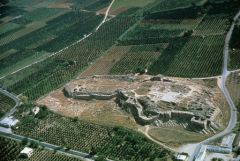
Ziggurat, Ur
a. What is the period? b. What is the construction material? c. How does this work conform to the period? |
a. Sumer Third Dynasty of Ur. Page 41
b. Baked brick, laid in bitumen for the facing of the entire monument. Page 42 c. It reiterates the importance of religion in this society; this is one of the largest ziggurats constructed at this time. Page 41 |
|
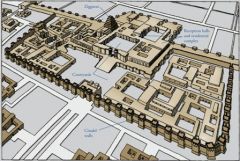
How does this citadel reflect the image that the Assyrians wanted to project?
|
It expresses the might of the Assyrians and Sargon II. The strong defensive walls show the nature of the times, a period of almost constant warfare. The palace has a basic symmetry, however it does ramble across the landscape. It is a grand expression of the power and might of the Assyrians in general and Sargon II in particular. Page 45
|
|

a. What is this?
b. Why is this work significant? c. How does this image express power? d. What is the medium? |
a. Probably an episode from the campaigns of Ashurnasirpal, as he drove his enemies into the Euphrates River; a battle sequence. Page 46
b. It is narrative detail that is distinct and unequaled in the Ancient Near East. Only Rome would create as complete a narration as the ancient Assyrians, and this relief highlights the strength of the army and their prowess in battle. Page 46 c. It tells the story in as complete detail as possible, it is vivid and legible, and all who saw this could understand easily the content. It is a reflection of the power of Ashurnasirpal and his victory. Page 47 d. (painted) Gypsum relief. Page 46 |
|

a. How does this work express the Sumerian design?
b. How does this work reflect Sumerian society? c. How does the work express Sumerian religious thought? d. What is the medium? |
Warka Vase
a. The innovative presentation of the three tiers (bands or registers) will have a long history in the visual vocabulary. The artist has presented the figures conceptually consistent with previous renderings, the stately procession of men with offerings conforms to Sumerian design. Page 35 b. It presents a view of a deeply committed people, expressing thanks to their goddess. Page 35 c. It presents a view of the profoundly held religious views of the people, as they are gathering to present to the goddess offerings in thanks for her generous assistance in increasing crops and herds. Page 35 d. Alabaster. Page 34 |
|
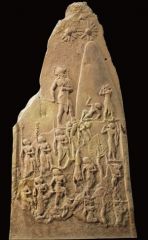
a. Why is this work significant?
b. What stylistic innovations are present in this work that distinguish it from earlier Mesopotamian art? c. What is the medium? |
Victory Stele of Naram-Sin
a. The king is presented in the horned helmet of the god, signifying his divinity, a complete change from earlier traditions. This presentation gives the king the divine power. He is invincible; the gods are not primary in his victory, and he is completely responsible for the conquest of the Lullubi. Page 40 b. The artist created an innovative composition by setting the scene in a landscape and by placing the figures within this landscape, instead of organizing the figures in horizontal registers. Page 41 c. Pink sandstone. Page 40 |
|
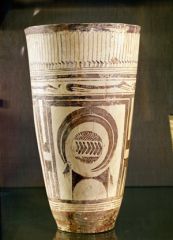
Beaker with animal decoration
(Figure 2-1A) a. Where were many of these beaker vessels found? b. What kinds of motifs are represented on these beakers? c. What was the painter's overall design for this beaker? |
Beaker with animal decoration
a. They come from graves. These vessels, which often feature animals and abstract motifs painted in a flat brown glaze, were precious gifts to the dead to be used in the afterlife. b. Save for the rectilinear frames and a central circular herringbone pattern, all the motifs on this beaker are stylized animals shown in profile view, consistent with the way humans had represented animals since Paleolithic times (see Chapter 1). c. The painter created a dynamic balance of surface patterns by alternating left- and right-facing animals and tall and short horizontal zones. The primary motif is a large bearded ibex. The rectangle that frames the ibex tapers at the bottom, repeating the beaker's silhouette. All around the top of the beaker are wading marsh birds with enormously elongated necks. |
|
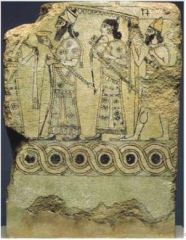
a. What makes this work rare?
b. How do we know which figure is king Ashurnasirpal ? c. How does this painting reveal what reliefs would look like? |
Ashurnasirpal II
a. Assyrian paintings, because of their fragile nature, are much rarer today than stone reliefs. One example that does survive comes from Ashurnasirpal II's Kalhu palace. It is painted in glazed brick, a much more durable format than direct painting on plastered mud-brick walls, the technique used a millennium earlier. b. The Kalhu panel shows the king, taller than everyone else as befits his rank, delicately holding a cup. c. Painted scenes such as this hint at what the Assyrian stone reliefs might have looked like with their original paint intact, although the reliefs would have featured a wider range of colors than were available to the ceramic painter. |

